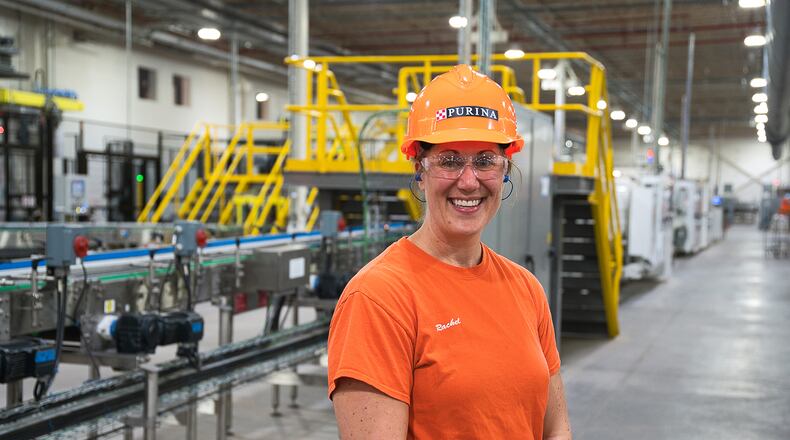Georgia’s jobless rate fell to 3.4% in October, the lowest it’s been since the state started keeping up with the statistic 43 years ago.
According to a report Thursday from the Georgia Department of Labor, the number of people out of work and searching for a job dropped to below 175,000. Just once since 1976 has the state matched last month's unemployment rate — toward the end of the tech boom, 18 years ago.
"It was 2001 when we last saw the number of unemployed this low in Georgia," said Mark Butler, the state's labor commissioner. "And there were a million fewer people in the work force back then."
The dramatic growth in the workforce has been the human fuel that has powered the economy through a record-long expansion. Since 2010, the state has added 805,000 jobs, including 5,400 last month.
The national economy, too, saw solid hiring in October, although the U.S. unemployment rate inched up from 3.5% to 3.6%. The all-time low for U.S. unemployment rate came in 1953, when joblessness fell to 2.5%.
In 2000, when Georgia’s jobless rate was 3.4 %, the economy was nearing the end of a decade-long expansion. Three months later, a recession began.
There are no signs of a similar downturn yet.
The only weakness in Thursday’s report was data showing that the flow of people into the workforce might be tapering off.
Three years ago, Georgia's labor force was growing at an annual pace of more than 150,000. By October 2018, that had slowed to 22,774. And, in the past 12 months, the labor force has grown by 4,107, according to the Labor Department report.
That slowdown in labor force parallels a modest deceleration in job growth.
So far this year, Georgia has added 54,000 jobs, the fewest of any year since 2011. Hiring rates were 1.5% lower than a year ago, according to an analysis by LinkedIn.
There’s no indication that America’s current trade battles have badly damaged Georgia’s overall economy.
One puzzle, however, has emerged. Typically, when unemployment rates fall, wages rise as companies start bidding to lure – or keep – workers. But that has not happened this time. During the tech boom, average hourly earnings rose nearly 4% a year.
During the current expansion, earnings growth has not yet reached 3%, according to the Bureau of Labor Statistics.
Georgia's strongest sector in October was hospitality, which added 4,400 jobs. Education and health grew by 3,400, the Labor Department reported. And the trade and transportation sector, which would be hurt by anything that chills trade, added 2,100 jobs.
Retail – undermined by online ordering – saw a slight decline during the month. That’s despite the approach of holiday shopping, which usually means a surge of hiring.
Still, some retailers are growing.
Dollar General, which opened a new store in McDonough in October, has avoided some of the weakness seen in other big retail chains, said spokeswoman Crystal Ghassemi.
“We are today’s general store,” she said. “Cleaning supplies, shampoo, something for your child’s birthday party.”
Dollar General has 900 stores in Georgia, each with six to 10 employees. The company also recently opened a 450-worker, 1 million square-foot distribution center in Butts County.
And, while manufacturing was weak during the month, the sector has added 3,000 jobs during the past year – with some of the growth coming from factories that are aimed exclusively at the American market.
For example, Nestle Purina on Monday will officially open a new manufacturing plant in Hartwell that will produce pet food for the Southeast, according to Rachel Miller, factory manager. The operation has grown from four employees in early 2018 to 200 currently, with plans to add about 40 more.
But the low unemployment rate and stagnant growth in the workforce means companies – including Nestle Purina – must take more time to find the people they need. Some kinds of technicians are especially scarce, Miller said.
The company has worked with the state Labor Department and with local economic development groups, she said. "We've had good partnerships to get our name out," she said. "There's a market shortage."
Georgia job growth, Jan-Oct.
2014: 105,100
2015: 89,200
2016: 76,600
2017: 58,200
2018: 74,400
2019: 54,000
Sources: Bureau of Labor Statistics, Georgia Department of Labor
Georgia job growth, October
2014: 2,500
2015: 16,000
2016: -3,600
2017: 22,300
2018: 10,700
2019: 5,400
Sources: Bureau of Labor Statistics, Georgia Department of Labor
October unemployment rate
2010: 10.6%
2011: 10.1%
2012: 8.8%
2013: 7.8%
2014: 6.8%
2015: 5.7%
2016: 5.4%
2017: 4.4%
2018: 3.7%
2019: 3.4%
Sources: Bureau of Labor Statistics, Georgia Department of Labor
12-month growth in the Georgia’s labor force
Oct. 2014: 10,838
Oct. 2015: 38,861
Oct. 2016: 184,166
Oct. 2017: 117,629
Oct. 2018: 22,774
Oct. 2019: 4,107
Note: Labor force includes everyone who is either working or looking for work.
Sources: Bureau of Labor Statistics, Georgia Department of Labor
About the Author
Keep Reading
The Latest
Featured



